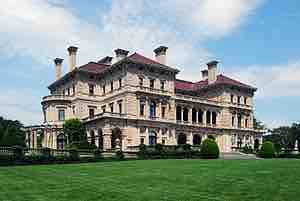In United States history, the Gilded Age was the period following the Civil War, running from the late 1860s to about 1896 when the next era began, the Progressive Era. The term was coined by writers Mark Twain and Charles Dudley Warner in The Gilded Age: A Tale of Today, which satirized what they believed to be an era of serious social problems obscured by a thin veneer of prosperity.
The Gilded Age was a time of enormous growth that attracted millions of European immigrants. Railroads were the major industry, but the factory system, mining, and labor unions also gained in importance . Despite the growth, there was serious cause for concern, which manifested in two major nationwide depressions, known as the Panic of 1873 and the Panic of 1893. Furthermore, most of the growth and prosperity came in the North and West - states that had been part of the Union. States in the South, part of the defeated Confederate States of America, remained economically devastated; their economies became increasingly tied to cotton and tobacco production, which suffered low prices. African Americans in the south experienced the worst setbacks, as they were stripped of political power and voting rights.

Gilded Age
The Breakers, the summer home of Cornelius Vanderbilt II, located in Newport, Rhode Island, United States. It was built in 1893, added to the National Register of Historic Places in 1971, and designated a National Historic Landmark in 1994.
During the 1870s and 1880s, the U.S. economy rose at the fastest rate in its history, with real wages, wealth, gross domestic product (GDP), and capital formation all increasing rapidly. Between 1865 and 1898, the output of wheat increased by 256%, corn by 222%, coal by 800% and miles of railway track by 567%. Thick national networks for transportation and communication were created. The corporation became the dominant form of business organization, and a managerial revolution transformed business operations. By the beginning of the 20th century, per capita income and industrial production in the United States led the world, with per capita incomes double that of Germany or France, and 50% higher than Britain.
Politics in the Gilded Age
Gilded Age politics, called the Third Party System, were characterized by rampant corruption and intense competition between the two parties (with minor parties coming and going), especially on issues of Prohibitionist, labor unions and farmers. The Democrats and Republicans fought over control of offices as well as major economic issues. The dominant political issues included rights for African Americans, tariff policies and monetary policies. Reformers worked for civil service reform, prohibition and women's suffrage, while philanthropists built colleges and hospitals, and the many religious denominations exerted a major sway in both politics and everyday life.
Voter turnout was very high and often exceeded 80% or even 90% in some states as the parties were adamant about rallying their loyal supporters. Competition was intense and elections were very close. In the South, lingering resentment over the Civil War meant that most states would vote Democrat. After the end of Reconstruction in 1877, competition in the South took place mainly inside the Democratic Party. Nationwide, voter turnout fell sharply after 1900.
The Third Party System (1854-1890s)
The Third Party System lasted from about 1854 to the mid-1890s, and featured profound developments in issues of nationalism, modernization, and race. It was dominated by the new Republican Party (also known as the Grand Old Party or GOP), which claimed success in saving the Union, abolishing slavery and enfranchising the freedmen, while adopting many Whiggish modernization programs such as national banks, railroads, high tariffs, homesteads, social spending (such as on greater Civil War veteran pension funding), and aid to land grant colleges. While most elections from 1874 through 1892 were extremely close, the opposition Democrats won only the 1884 and 1892 presidential elections. The northern and western states were largely Republican, save for closely balanced New York, Indiana, New Jersey, and Connecticut. After 1874, the Democrats took control of the "Solid South. "
The Fourth Party System (1896-1932)
The Fourth Party System lasted from about 1896 to 1932, and was dominated by the Republican Party, excepting the 1912 split in which Democrats held the White House for eight years. American history texts usually call it the Progressive Era, and it included World War I and the start of the Great Depression. The period featured a transformation from the issues of the Third Party System, instead focusing on domestic issues such as regulation of railroads and large corporations ("trusts"), the money issue (gold versus silver), the protective tariff, the role of labor unions, child labor, the need for a new banking system, corruption in party politics, primary elections, direct election of senators, racial segregation, efficiency in government, women's suffrage, and control of immigration. Foreign policy centered on the 1898 Spanish-American War, Imperialism, the Mexican Revolution, World War I, and the creation of the League of Nations.